Jan 17
Posted: under Activities, Land, Plantlife, Water, Wildlife.
Tags: Activities, beauty, butterflies, census, new species, photography, Weather January 17th, 2010
We’d had some sprinkles, but the first real rain came Thursday & Friday, about two inches, and set the secondary drainage flowing across the near meadow again. Creek was up and a little turbid, but the flow in the grass was crystal clear. Today, I finally photographed a common (supposedly) species of butterfly around here, […] [...more]
We’d had some sprinkles, but the first real rain came Thursday & Friday, about two inches, and set the secondary drainage flowing across the near meadow again. Creek was up and a little turbid, but the flow in the grass was crystal clear. Today, I finally photographed a common (supposedly) species of butterfly around here, which I’d never been able to catch in the lens.
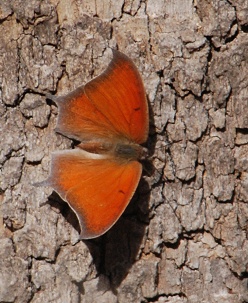 Read the rest of this entry »
Read the rest of this entry »

Nov 12
Posted: under Activities, photography, Water, Wildlife.
Tags: Activities, beauty, butterflies, native plants, photography, water resource management November 12th, 2009
Two years of drought followed by heavy rains in a warm fall has produced bursts of spring flowering and some spring butterflies even as it’s produced sudden fall color…a very odd combination. [...more]
Two years of drought followed by heavy rains in a warm fall has produced bursts of spring flowering and some spring butterflies even as it’s produced sudden fall color…a very odd combination.
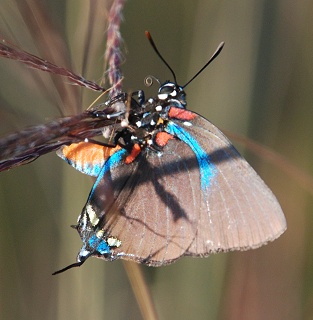
Read the rest of this entry »

Nov 10
Posted: under photography, Plantlife, Water.
Tags: butterflies, native plants, odonates, photography, prairie restoration, water resource management November 10th, 2009
We have no permanent natural water on the place. But when it does rain, we have a variety of temporary water sources, from the actual creek to the various overflow channels (some of concern because of erosion; others now pretty much “tamed.”) [...more]
We have no permanent natural water on the place. But when it does rain, we have a variety of temporary water sources, from the actual creek to the various overflow channels (some of concern because of erosion; others now pretty much “tamed.”)
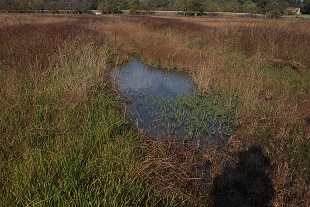
Read the rest of this entry »

Nov 06
Posted: under Activities, photography, Plantlife, Wildlife.
Tags: Activities, beauty, butterflies, census, native plants, photography, prairie restoration November 6th, 2009
Some grasses should be planted just for the way they look with sunlight slanting through them in the fall. This is one. It’s one of the Muhlys, but I don’t know which. [...more]
Some grasses should be planted just for the way they look with sunlight slanting through them in the fall.
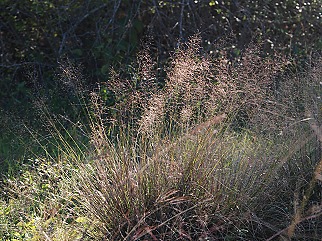
This is one. It’s one of the Muhlys, but I don’t know which.
Read the rest of this entry »

Nov 04
Posted: under Plantlife, Wildlife.
Tags: beauty, butterflies, insect, native plants, photography November 4th, 2009
The dry-woods swale is slowly drying up: The pale area is where water stood for several weeks. [...more]
The dry-woods swale is slowly drying up:
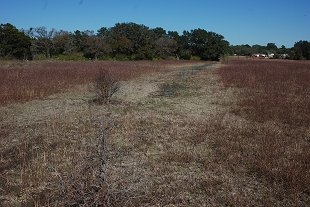
The pale area is where water stood for several weeks.
Read the rest of this entry »

Sep 27
Posted: under photography, Plantlife, Wildlife.
Tags: beauty, butterflies, native plants, photography September 27th, 2009
Though we lost the two planted cypresses to the drought, and some of the water iris we’d planted in the “swamp”, this one survived and is now coming back up from the corm. The water here is about an inch deep–this is an overflow/seep channel off the main creek; 8.5 inches didn’t put more than […] [...more]
Though we lost the two planted cypresses to the drought, and some of the water iris we’d planted in the “swamp”, this one survived and is now coming back up from the corm.
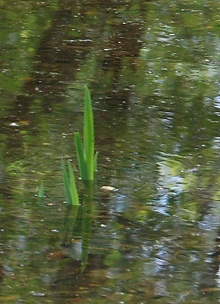
The water here is about an inch deep–this is an overflow/seep channel off the main creek; 8.5 inches didn’t put more than a flood pulse through it, but the final 1.5 inches left this wide shallow pool…and a brave little iris.
Read the rest of this entry »

May 29
Posted: under photography, Wildlife.
Tags: beauty, butterflies, photography May 29th, 2009
Among everyone’s favorite wildlife (and insects) are butterflies. The drought last year meant little for butterfly larvae to eat, and thus few butterflies early in the year (and those we had were markedly smaller than the previous year.) But the rains over a month ago made it possible for some wanderers to lay eggs, and […] [...more]
Among everyone’s favorite wildlife (and insects) are butterflies. The drought last year meant little for butterfly larvae to eat, and thus few butterflies early in the year (and those we had were markedly smaller than the previous year.) But the rains over a month ago made it possible for some wanderers to lay eggs, and those eggs to survive, hatch, and the larvae to pupate…so now we have more butterflies.
I can’t get good pictures of the fast-flying species of sulfurs who are our dominant types, nor did I catch the big tiger swallowtail in the back yard, but here’s some of what was flying (and cooperative about photography) in the past week.
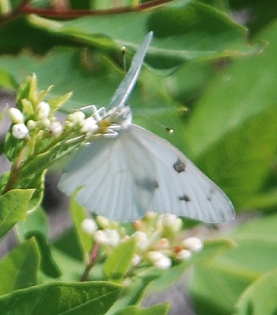
This Checkered White is trying to nectar on dogbane (the flowers mostly still in bud.)
Read the rest of this entry »

Mar 31
Posted: under photography, Wildlife.
Tags: beauty, butterflies, photography, wildlife management March 31st, 2009
Monarchs come through central Texas in both the spring and fall migrations. In spring, they particularly need wild milkweeds on which to lay eggs, but they also need flowers that provide nectar, in case they must fly farther to find the milkweeds (and this year, that’s important. Because of drought, the milkweed abundance is way […] [...more]
Monarchs come through central Texas in both the spring and fall migrations. In spring, they particularly need wild milkweeds on which to lay eggs, but they also need flowers that provide nectar, in case they must fly farther to find the milkweeds (and this year, that’s important. Because of drought, the milkweed abundance is way down on our place.)
I usually see monarchs mating while perched on Ashe junipers–as wind protection–and nectaring on whatever’s blooming. Some years, they have a choice. This year, because of the drought, not much choice. The reliable woody shrubs bloom even when the flowering forbs are scarce. Rusty blackhaw viburnum and wild plum (both the Mexican plum and the thicketing plum) provided monarch feeding stations this year.
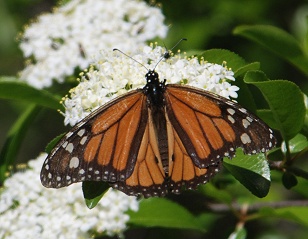
This particular viburnum overhangs the creekbed (now dry) and is at least twenty feet tall. Sunday it was covered with white flower clusters. Since we’ve owned the place, excluding livestock from the creek woods has allowed the growth of new viburnums, so in another ten to twenty years, we should have a lot of flowering shrubs–and some very happy monarchs.
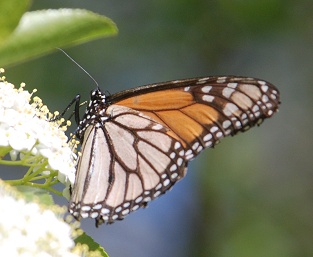
Read the rest of this entry »










